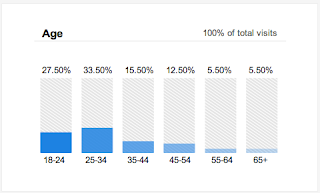The American Geophysical Union (AGU) belongs to the International Union of Geodesy and Geophysics (IUGG). In fact, most international science groups in this field include geodesy in their name before geophysics while AGU omits it altogether. (This is another example of American exceptionalism that you can use in your holiday cocktail party chatter.)
If you have more than a minute, may I suggest you read more about the remarkable satellites that measure the earth's time-varying gravitational field?
The "Potsdam Gravity potato", as this representation of terrestrial gravity has become known, can for the first time display gravity variations that change with time. The seasonal fluctuations of the water balance of continents or melting or growing ice masses, i.e. climate-related variables, are now included in the modeling of the gravity field. "EIGEN-6C" is the name of this latest global gravity field model of the GFZ German Research Centre for Geosciences. It was recently calculated in Potsdam in cooperation with the Groupe de Recherche de Géodésie Spaciale from Toulouse. This new gravity field model is based on measurements of the satellites LAGEOS, GRACE and GOCE. These were combined with ground-based gravity measurements and data from the satellite altimetry. EIGEN-6C has a spatial resolution of about 12 kilometres. Compared to the last version of the Potsdam potato, this is a four-fold increase.The twin GRACE satellites are shown with the (vertically-exaggerated) gravity potato. The GPS satellites, without which these measurements could not be taken, are not shown in this picture. From Gravity is Climate:
"Of particular importance is the inclusion of measurements from the satellite GOCE, from which the GFZ did its own calculation of the gravitational field' says Dr. Christoph Foerste, who together with his colleague Dr. Frank Flechtner directs the gravitaty field work group at the GFZ. The ESA mission GOCE (Gravity Field and Steady-State Ocean Circulation Explorer) was launched in mid-March 2009 and since then measures the Earth's gravitational field using satellite gradiometry.
Read more at: http://phys.org/news/2011-06-seasonal-potato-recalculation-potsdam-geoid.html#jCp
For the first time, the melting of glaciers in Greenland could now be measured with high accuracy from space. Just in time for the tenth anniversary of the twin satellites GRACE (Gravity Recovery and Climate Experiment) a sharp image has surface, which also renders the spatial distribution of the glacial melt more precisely.From the Potsdam Potato page with downloadable animations!
The Greenland ice shield had to cope with up to 240 gigatons of mass loss between 2002 and 2011.
Two take-aways from this:
- The loss of arctic (northern hemisphere polar) ice is real, dramatic and has been measured for decades.
Every satellite measures the earth's gravitational field because satellite motions are determined by the sum of all the gravitational forces acting upon it. Geodesists have been poring over satellite Precision Orbit Determination (POD) data for decades and puzzling over the decrease in oblateness over the decades.
When JPL's Jean Dickey first proposed that the melting polar ice caps were changing the shape of the earth, people (men) made fun of her. She had looked at every other possible cause and determined that their effects were too small to account for the changes our satellites were sensing. Anyway, 10 years ago, they gave her a medal.
- Greenland ice mass loss is a major driver of increased arctic oscillation (AO), which I mentioned earlier in Boulder Flooding Links. It's also a major driver for events like snowmaggedon. It's a big deal to everything on the planet--not just polar bears.
Interesting asides:
GOCE made big news when it crashed back to earth earlier this month. Notice that it's predecessor satellites, CHAMP and GRACE, remained in orbit for a decade and GOCE lasted less than four? There's a good reason for that. GOCE gained higher resolution by orbiting closer to the earth. The higher atmospheric drag at the lower altitude dragged it back to earth faster.
GOCE's very sleek, slim design also allowed it to deorbit relatively smoothly, without much tumbling motion. GOCE was able to maintain radio contact with an Antarctic station to an astonishingly low altitude just minutes before the final crash landing. How's that for antenna pointing under difficult conditions?






















